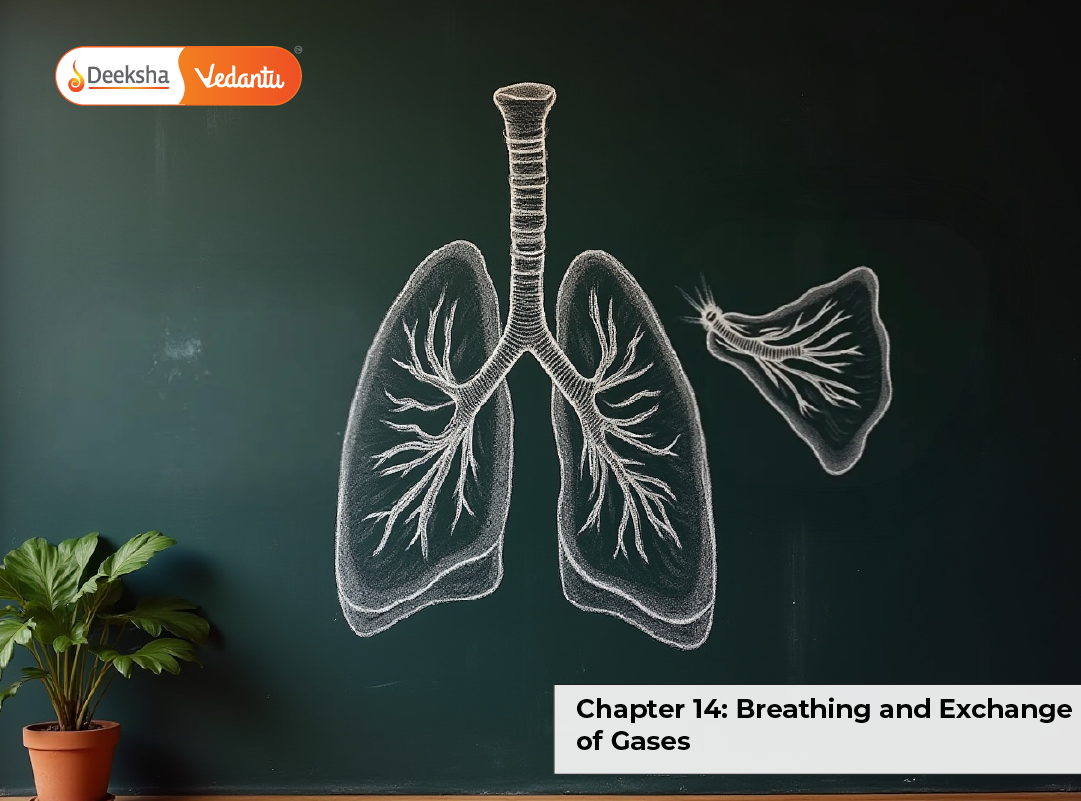Introduction
Breathing and exchange of gases is a core chapter in human physiology and an important topic for NEET. It explains how oxygen is inhaled and carbon dioxide is exhaled through the process of respiration. This chapter builds your understanding of how gases are exchanged at the alveolar and tissue level, and how they are transported in the blood. It integrates structural anatomy, physiological mechanisms, and chemical reactions crucial to cellular respiration.
Human Respiratory System
Organs Involved:
- Nasal cavity: Filters, warms, and moistens incoming air.
- Pharynx: Common pathway for both air and food.
- Larynx (voice box): Prevents food from entering trachea; involved in sound production.
- Trachea: Tube supported by C-shaped cartilaginous rings to prevent collapse.
- Bronchi and bronchioles: Branches into lungs; regulate air flow.
- Alveoli: Tiny sacs where actual gas exchange takes place.
Key Features:
- Alveoli are lined with a thin squamous epithelium and surrounded by blood capillaries for efficient gas exchange.
- Pleural membrane: Encloses the lungs and helps reduce friction during breathing movements.
Mechanism of Breathing
Inspiration (Inhalation):
- Diaphragm contracts and flattens.
- External intercostal muscles contract to expand the rib cage.
- Thoracic cavity volume increases.
- Intrapulmonary pressure decreases.
- Air flows into lungs due to pressure gradients.
Expiration (Exhalation):
- Diaphragm relaxes.
- Internal intercostal muscles contract.
- Thoracic cavity volume decreases.
- Intrapulmonary pressure increases.
- Air is expelled from lungs.
Types of Breathing:
- Eupnea: Normal quiet breathing.
- Hyperpnea: Forced or deep breathing.
- Apnea: Temporary cessation of breathing.
Lung Volumes and Capacities
| Volume/Capacity | Approx. Value | Description |
| Tidal Volume (TV) | 500 mL | Air exchanged during normal breathing |
| Inspiratory Reserve Volume (IRV) | 2500–3000 mL | Extra air inhaled forcibly after a normal inhalation |
| Expiratory Reserve Volume (ERV) | 1000–1100 mL | Extra air exhaled forcibly after a normal exhalation |
| Residual Volume (RV) | 1100–1200 mL | Air remaining in lungs after maximum exhalation |
| Inspiratory Capacity (IC) | 3000–3500 mL | TV + IRV |
| Functional Residual Capacity (FRC) | 2100–2300 mL | ERV + RV |
| Vital Capacity (VC) | 4500 mL | TV + IRV + ERV |
| Total Lung Capacity (TLC) | 5800–6000 mL | VC + RV |
Exchange of Gases
At Alveolar Level:
- Oxygen diffuses from alveoli to pulmonary capillaries due to higher pO₂ in alveoli.
- Carbon dioxide diffuses from blood to alveoli due to higher pCO₂ in blood.
At Tissue Level:
- Oxygen diffuses from blood to tissues where pO₂ is lower.
- Carbon dioxide diffuses from tissues to blood where pCO₂ is lower.
Transport of Gases
Oxygen Transport:
- 97% binds to hemoglobin forming oxyhemoglobin.
- 3% dissolves directly in plasma.
Carbon Dioxide Transport:
- 70% as bicarbonate ions (HCO₃⁻)
- 20-25% as carbaminohemoglobin (bound to hemoglobin)
- 7% dissolved in plasma
Oxygen Dissociation Curve
- The curve is sigmoid-shaped due to cooperative binding.
- Right shift of curve indicates reduced affinity of hemoglobin for oxygen.
- Right shift occurs in conditions like:
- Increased CO₂ (pCO₂)
- Decreased pH (Bohr effect)
- Increased temperature
Bohr Effect:
- Describes how low pH or high CO₂ reduces hemoglobin’s affinity for oxygen, facilitating oxygen release in tissues.
Regulation of Respiration
- Controlled by respiratory centers in medulla oblongata and pons.
- Medullary rhythmicity center sets basic rhythm.
- Chemoreceptors detect changes in CO₂ and pH.
- Stretch receptors in lungs prevent over-inflation (Hering-Breuer reflex).
Disorders of Respiratory System
| Disorder | Cause | Symptoms |
| Asthma | Inflammation and narrowing of bronchi | Wheezing, coughing, breathlessness |
| Emphysema | Damage to alveolar walls | Shortness of breath, fatigue |
| Bronchitis | Inflammation of bronchi | Productive cough, mucus |
| Pneumonia | Bacterial or viral infection | Fever, chills, chest pain |
| Occupational Lung Diseases | Inhalation of harmful dust | Silicosis, asbestosis |
NEET Corner: Sample Questions
- Which lung volume cannot be measured using a spirometer?
- a) TV
- b) ERV
- c) RV ✅
- d) VC
- Most CO₂ is transported in blood as:
- a) Carbaminohemoglobin
- b) Dissolved gas
- c) Carbonic acid
- d) Bicarbonate ✅
- Bohr effect is associated with:
- a) O₂ uptake by hemoglobin
- b) Release of CO₂
- c) Effect of pH on O₂-Hb dissociation ✅
- d) CO₂ transport
- Which gas has the highest diffusion coefficient in blood?
- a) Oxygen
- b) Carbon dioxide ✅
- c) Nitrogen
- d) Helium
- Which part of the brain regulates involuntary breathing?
- a) Cerebrum
- b) Cerebellum
- c) Medulla oblongata ✅
- d) Hypothalamus
FAQs
What is the tidal volume in humans?
It is approximately 500 mL of air exchanged during quiet breathing.
Why is the oxygen dissociation curve sigmoid?
Because of cooperative binding of oxygen molecules to hemoglobin.
How is carbon dioxide transported in blood?
Mainly as bicarbonate ions (HCO₃⁻), followed by carbaminohemoglobin and dissolved CO₂.
Which part of the brain regulates breathing?
The medulla oblongata and pons control the rhythm of respiration.
What is vital capacity?
It is the maximum amount of air that can be exhaled after a maximum inhalation – sum of TV, IRV, and ERV.
What is the role of hemoglobin in gas transport?
Hemoglobin binds to oxygen to form oxyhemoglobin, facilitating oxygen delivery to tissues.
What is residual volume and why is it important?
It is the air left in lungs after forceful expiration (~1200 mL), essential to prevent alveolar collapse.
Conclusion
Understanding the concepts of Breathing and Exchange of Gases forms the backbone of respiratory physiology. This chapter is not only significant for NEET but also lays the foundation for advanced medical studies. Focus on learning the structure and function of each respiratory component, the mechanics of breathing, lung capacities, and gas transport systems. Diagram practice, curve analysis, and disease mechanism understanding can help you score well in NEET. Make sure to practice as many MCQs as possible to test your grasp on key concepts.




Get Social